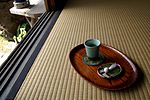Wabi-cha (わび茶; 侘茶; 侘び茶), is a style of Japanese tea ceremony particularly associated with Sen no Rikyū, Takeno Jōō and its originator Murata Jukō. Wabi-cha...
4 KB (566 words) - 09:22, 24 June 2021
In traditional Japanese aesthetics, wabi-sabi (侘び寂び) is a world view centered on the acceptance of transience and imperfection. The aesthetic is sometimes...
22 KB (2,620 words) - 12:10, 17 July 2024
Schools of Japanese tea (section Buke-cha)
the wabi-cha manner of tea ceremony, another style of tea ceremony, called buke-cha (武家茶, "warrior household tea") (also referred to as daimyo-cha (大名茶))...
15 KB (1,972 words) - 02:11, 10 December 2023
Chashitsu (redirect from Cha-Shitsu)
article "The Mountain Dwelling Within the City", the ideal of wabi-style tea ceremony (wabi-cha) had its roots in the urban society of the Muromachi period...
20 KB (2,439 words) - 20:39, 2 June 2024
influence on chanoyu, the Japanese "Way of Tea", particularly the tradition of wabi-cha. He was also the first to emphasize several key aspects of the ceremony...
17 KB (2,266 words) - 08:01, 8 June 2024
of the Japanese tea ceremony, in that he was the early developer of the wabi-cha style of tea enjoyment employing native Japanese implements. His name may...
7 KB (795 words) - 14:51, 30 May 2024
influence on chanoyu, the Japanese "Way of Tea", particularly the tradition of wabi-cha Charlie Chaplin (1889–1977) actor of Silent Era Sugihara Chiune (1900–1986)...
15 KB (1,493 words) - 01:06, 15 May 2024
Japanese tea ceremony (redirect from Cha-no-yu)
ceremony, and perfected the tea ceremony based on the aesthetic sense of wabi. Sen no Rikyū's great-grandchildren founded the Omotesenke, Urasenke, and...
63 KB (7,630 words) - 06:50, 6 July 2024
defective utensils, in the wabi-sabi spirit, is called wabi-cha. However, Jukō did not attach any particular importance to wabi: it was the disciple of one...
104 KB (13,127 words) - 20:00, 5 June 2024
with Sen no Rikyū, known as the founder of the Japanese tea ceremony "wabi-cha", and who was later put to death by Hideyoshi himself. Kuroda was a frugal...
16 KB (1,877 words) - 19:54, 4 July 2024
Nagaakira. In Enshō, Sōko recreated an 'Oribe-kaku' tea room. This is small, wabi-cha tearoom with an extra tatami mat added to the left of the alcove to form...
18 KB (2,349 words) - 17:18, 20 March 2024
and exerted a great influence on the process of the concept building of wabi-cha. However, modern researchers believe that the book contains information...
3 KB (392 words) - 10:01, 3 March 2024
cultural history because he followed Murata Jukō as an early proponent of wabi-cha, and was chanoyu teacher to Sen no Rikyū. It is believed that the family...
3 KB (390 words) - 17:33, 2 September 2021
Ueda Sōko-ryū (section Wabi-cha and Warrior Tea)
emphasising the aesthetic concept of wabi. The Ueda Ryū is a School of chanoyu that values wabi-cha and emphasises wabi aesthetics. Another dimension to the...
42 KB (6,562 words) - 14:24, 28 March 2024
Bamboo hanaire (take-hanaire) came into being with the development of wabi-cha, as did hanaire of domestic Japanese ceramic ware such as Bizen ware and...
42 KB (4,956 words) - 20:36, 2 June 2024
influence on chanoyu, the Japanese "Way of Tea", particularly the tradition of wabi-cha The Attacks of 26/11 (2013) – Indian Hindi-language action thriller film...
291 KB (31,458 words) - 13:03, 15 July 2024
tea master Sen no Rikyū (1522–1591) who advocated for a simple, austere wabi-cha style with natural and spontaneous or seemingly artless utensils. These...
65 KB (6,049 words) - 21:26, 7 August 2023
Tea ceremony is a ritualized practice of making and serving tea (茶 cha) in East Asia practiced in the Sinosphere. The original term from China (Chinese:...
13 KB (1,534 words) - 12:02, 10 March 2024
Uji tea (宇治茶, Uji-cha) is a common name for all Japanese green tea produced from Uji, Kyoto. The three main types of Uji tea are Matcha, Sencha and Gyokuro...
22 KB (2,769 words) - 09:23, 21 March 2024
and splendour in the tea ceremony, preferring the austere beauty of the wabi-suki aesthetic. Different sources also pronounce his name as "Pechikwan"...
6 KB (687 words) - 16:16, 3 May 2024
shape, so most Seto-made Tenmoku chawan had this shape. With the rise of the wabi tea ceremony in the late Muromachi period (1336–1573), the Ido chawan, which...
9 KB (883 words) - 09:46, 24 June 2024
coordinator of the Mediterranean Astronomical Network. JPL · 10584 10585 Wabi-Sabi 1996 GD21 Wabi-sabi is a Japanese aesthetic centered around imperfection. JPL ·...
178 KB (428 words) - 07:05, 4 July 2024
Tar Surat Permpoonsawat (Yacht) as Pond Nachjaree Horvejkul (Cherreen) as ChaAim Pirapat Watthanasetsiri (Earth) as Type Phurin Ruangvivatjarus (M) as...
10 KB (891 words) - 19:53, 4 July 2024
Myers: AM Amy Bond: AB Ayana Ife: AI Batani-Khalfani: BT Brandon Kee: BK ChaCha: CC Claire Buitendorp: CB Deyonté Weather: DW Kentaro Kameyama: KT Kenya...
24 KB (1,580 words) - 06:24, 12 May 2024
often uneven design, epitomizing the traditional Japanese aesthetics of wabi-sabi ("perfection in imperfection"). The Tokiko calls the Rusun and Namban...
47 KB (4,561 words) - 06:35, 29 May 2024
design. The room's opulence was highly unusual and may have also been against wabi-sabi norms. At the same time, the simplicity of the overall design with its...
16 KB (1,700 words) - 04:24, 12 June 2024
flawed utensils with a wabi aesthetic came to be referred to as wabicha. Shukō, however, did not embrace the idea of a fully wabi approach to chanoyu. By...
23 KB (3,059 words) - 06:58, 6 July 2024
often uneven design, epitomizing the traditional Japanese aesthetics of wabi-sabi ("perfection in imperfection"). The Spanish historian Antonio de Morga...
18 KB (1,905 words) - 08:21, 18 June 2024





















